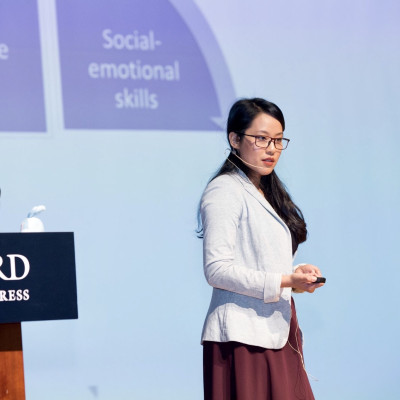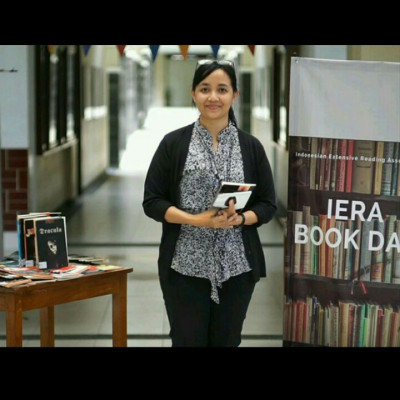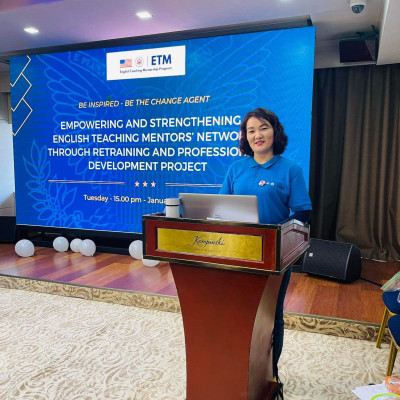Sessions / Presentation (45 minutes)
These will be 45 minutes including Q and A.
Extensive Reading and Reading Fluency: Promises and Limitations #4452
A considerable body of empirical research supports the belief that extensive reading is an effective way for second language learners to develop greater reading fluency. However, recent research indicates that extensive reading alone is not the most effective way to promote greater fluency. In this presentation I first review theories of fluency development proposed by cognitive psychologists and synthesize the key ideas in those studies. This synthesis produces a short list of desirable characteristics of fluency-enhancing reading tasks. I then consider how well extensive reading and other types of reading activities have those desirable characteristics, in what ways these activities appear to be lacking, and how their potential weaknesses can be addressed. This analysis shows that although extensive reading is an indispensable part of a fluency-based reading course, fluency development can be enhanced by using supplementary reading tasks.
Incorporating AI into two Extensive Reading programs #4107
This presentation will introduce ER programs at two separate universities, one incorporating xreading and another utilizing physical books, and will review the activities in both programs. After reviewing these two programs and their implementation, I will discuss how AI has been incorporated in the form of Google NotebookLM to support extensive reading. Google NotebookLM, is a Google AI-powered tool that helps users interact with documents and sources by summarizing, extracting information, and answering questions based on uploaded content. NotebookLM’s ability to generate audio summaries has the potential to enhance ER by improving comprehension and engagement. Surveys and semi-structured interviews with students will be presented to reveal student impressions of the tool. This presentation will then discuss how NotebookLM can be integrated into an ER program, as well as its benefits, challenges, and pedagogical implications, with the aim of offering insights into AI’s role in supporting extensive reading.
Implementing ER through XReading: Perceptions, Benefits and Challenges #4393
This presentation reports the preliminary results of an extensive reading (ER) program implemented using XReading, a subscription-based virtual library. Thirty-two students participated in a 9-week study as part of a college General English course in Taiwan. Using data from post-program questionnaires and focus group interviews, the study explores learners’ perceptions of XReading for ER and investigates ER’s impact on their attitudes towards reading in English, and perceived benefits and challenges. The study reveals that most participants responded positively to using XReading for the ER program. The findings indicate that learners generally perceived improvement in their overall reading ability, reading rate, vocabulary, and motivation to learn English. However, many failed to meet the reading goal due to time constraints, lack of interest, or selecting readers that were either too challenging or not to their preferences. Recommendations to enhance participation and guidance are discussed for better implementation of online ER programs.
The Five-Finger Rule in Action: Do Thai EFL Learners Really Use It? #4246
The Five-Finger Rule is a widely recommended strategy for selecting appropriate reading materials in Extensive Reading (ER) programs, particularly for language learners using graded readers. This study investigates how Thai university students apply and perceive the rule, and how they implement it, using an online survey to collect data from 64 students participating in an ER program. Data on the number of books they assessed, the number of difficult words they encountered, and their reasons for choosing a particular book were gathered. The findings revealed that most students (53.8%) selected books that fell within the recommended difficulty range, aligning with their goal of a moderate challenge that still allows for comprehension. Interestingly, 13.8% of students intentionally chose books at a higher difficulty level, motivated by a desire to expand their vocabulary. These findings suggest that students adapt the Five-Finger Rule based on personal reading goals and language learning strategies.
How to Train Young Brilliant Minds to be Culturally Aware Using Graded Readers #4055
Research has shown that children who are exposed to Extensive Reading from a young age not only excel in academic skills, but also develop empathy, moral judgement and become culturally sensitive. Equipping students to explore diverse perspectives has never been more crucial in this day and age. Bennett (1986) proposes six stages of acculturation that learners can move through to gain greater cultural awareness. With constant exposure, they develop their own personal ideas, ultimately assimilating the culture of others into their own worldview. In this presentation, we will explore theories of “Cultural Development” and the cultural trajectories in the students’ learning journey to assimilation using themes from Eli’s Real Lives Series Graded Readers as a stepping stone. At the end of the session, participants will have a better understanding of how to utilise Graded Readers for all CEFR levels.
Merging EL and ER into Extensive Viewing Videos with Captions #4057
This presentation will highlight how to create extensive reading content in video format that is free, fun, and effective. Teachers and materials writers can learn how to generate an endless supply of engaging media content that students can read through captions. The emergence of AI and various online tools, such as VEED.IO, has made it easy to provide captions for video and audio content. As a result, both the extensive listening and extensive reading movements are now merging with the development of extensive viewing. This presentation will demonstrate how teachers can create or find content for any level and how to add captions to videos to help students increase their reading time. Additionally, the presentation will explore the differences between reading blocks of text in paragraph format and reading captions on various devices, as well as how captions can serve as a bridge for developing a love for reading.
Sixth Graders’ Comprehension: Proficiency Analysis and Implication for EYL #4060
This study investigates the reading comprehension skills of 84 sixth-grade students in a primary school in Palembang, Indonesia, to identify their strengths and weaknesses in English language ing. Using 18 informal comprehension assessments and six teacher-developed English proficiency tests, data were analyzed through Smart-PLS 4.0. With three validated comprehension categories: literal, inferential, and critical, the Reading Comprehension (RC) measurement demonstrated strong reliability (Cronbach's Alpha -0.882, Composite Reliability = 0.923, Average Variance Extracted = 0.801). These categories exhibited positive correlations with English proficiency whose reliability is 0.65, 0.808, and 0.586 consecutively. The overall mean RC score was 26.57 with the highest category on literal and weakest critical. Meanwhile the mean English proficiency score was 87.46, being significantly influenced by Reading Comprehension for 27.9% (p = 0.007). The findings underscore the need for comprehensive reading strategies beyond mere word recognition and gender-responsive materials to enhance reading proficiency.
Dictionary Usage during Extensive Reading #4063
It is often recommended that learners not use a dictionary when doing Extensive Reading and instead rely on surrounding context to infer meaning of unknown words. The current research project, supported by a Japanese federal grant, is investigating how access to an integrated dictionary during ER correlates with learners’ ability to accurately guess meaning. Roughly 120 first-year English majors read 200-300,000 words using the ER application Xreading, which offers optional access to glossary definitions. At the beginning and end of the year, students report the reading strategies they use and take a test to gauge their ability to accurately guess meaning from context. This presentation will report results from the first three years of the research project. Results thus far do not indicate overall significant differences between control groups and those allowed dictionary access. Later stages of this research will include further replication and the addition of guessing from context training.
Promoting Multilingual Literacies in a Buddy Reading Program in South Africa #4074
This presentation explores multilingual practices implemented in an after-school buddy reading program with Grades 3 and 7 learners from a township school in South Africa. In this qualitative study, learners were provided with a selection of linguistically and culturally relevant books in both isiXhosa and English, enabling them to maintain their home language while simultaneously learning their first additional language. Given that the participants were emerging bilinguals, the study explored educational activities that valorise multilingualism, in a complementary manner to support multilingual development. Activities such as interactive reading with translanguaging, storytelling and retelling in both languages, and the use of bilingual storybooks were designed. The multilingual strategies implemented in the program supported linguistic development and enhanced learners’ confidence in their ability to use both languages in social and academic contexts. The study recommends promoting multilingualism to policymakers and educators, highlighting its importance in nurturing literacy, linguistic diversity, and cultural identity.
Extensive Reading in Private Language Center: Shifting EFL Teachers' Views #4147
This action research investigated a center-wide "Reading Challenge" Extensive Reading (ER) program within a private language center catering to Vietnamese EFL young learners (aged 6-12, A1-A2 levels), a context under-researched within the ER literature. The program, successfully conducted annually for four years, was followed by an attempt to integrate ER into individual classrooms. Data collected through pre- and post-program teacher interviews provided insights into teacher beliefs, attitudes, and encountered challenges. Findings revealed that the "Reading Challenge" allowed teachers to recognize its benefits for enhancing students' reading comprehension, vocabulary, and reading habits. However, integrating ER into regular classroom instruction proved challenging in terms of materials and time constraints, hindering widespread adoption. This study identifies key areas for program improvement specific to private language center contexts, offering valuable recommendations for both practitioners and researchers.
Embedding ER as Core Content in LMS CollegePathway and Academic Express 3 #4470
CollegePathway and Academic Express 3 are LMS platforms built on supereigo.com that support multiple English learning goals including TOEIC, EIKEN and university entrance exams. They are used by over 100 institutions across Japan and serve hundreds of thousands of students and teachers. In April 2025, we added Pearson Bank, a repository of 30 graded short stories ranging from abridged classics to original Pearson titles. Each story is accompanied by in platform vocabulary, grammar and comprehension exercises so that extensive reading becomes part of both the student learning experience and the teacher toolkit. This presentation describes the integration process including curriculum alignment and workflow embedding. We examine three months of log data to understand how teachers and students incorporate story reading and how story use aligns with overall platform engagement. This case offers a scalable model for embedding graded extensive reading as a central measurable component of language learning on large scale digital platforms.
Extensive Reading and Media Representation in Discourse Analysis #4239
Considering the significance of critical thinking skills in Discourse Analysis, this study explores the effectiveness of reading, particularly in analyzing the representation of the former Indonesian President Joko Widodo. Before engaging in discussion and paper writing, 20 sixth-semester intermediate English students read two 1,000-word newspaper articles weekly for five weeks on post-presidency activities. This task aims to enhance their critical reading skills, expose them to varied discourse strategies, and provide a rich foundation for discussion. After the discussion, students complete a questionnaire assessing the impact of reading on analytical engagement and discourse comprehension. Preliminary findings suggest that the task aids in identifying linguistic patterns, contextual influences, and ideological framing in media texts, leading to more nuanced discussions and deeper analytical insights. Utilizing a qualitative research method, this study highlights the role of reading in fostering critical thinking and discourse competence, reinforcing its value as a pedagogical tool in discourse analysis courses.
Encouraging Positive Attitudes toward English through Reading #4029
This presentation will highlight the impact of incorporating book-reading activities into the classroom to encourage Japanese elementary school students to learn English. Since the Japanese Ministry of Education (MEXT) officially launched English education at elementary schools in 2020, approximately 70% of students have expressed interest in studying English. However, reading activities remained underutilized in classrooms (MEXT, 2024). To address this, the presenter collaborated with schoolteachers to integrate storybook-based reading activities into lessons, fostering students’ familiarity with English texts. The study involved two classroom teachers and 37 sixth-grade students at a public elementary school in Japan. Activities included weekly teacher-led storytelling using a big book, collaborative reading among students, and independent reading of mini books as homework. Results showed that students improved their receptive test scores and increased their motivation to learn English. This session will provide participants with practical techniques and strategies for effectively integrating reading activities into English instruction.
Effect of Long-term ER on Productive Knowledge of High-Frequency Vocabulary #4030
Incidental vocabulary learning through ER has been examined for the uptake rate of new words learned, but ER also provides an opportunity to deepen knowledge of high-frequency words. This study examines the productive knowledge of high-frequency English vocabulary of Japanese university students of similar English proficiencies between those who have read over 430,000 tokens of ER and those with little or no ER experience. Subjects were tested on receptive and productive knowledge of the 2000 most frequent words of the NGSL (New General Service List) utilizing the testing application VocabLevelTest (McLean & Raine, 2019). ANOVA results showed a significant main effect of ER on productive vocabulary (p < .001, η² = .32), with similar effects observed for both NGSL 1-1000 and NGSL 1001-2000 word bands. These results suggest that ER contributes to strengthening productive knowledge of high-frequency words through repeated encounters in meaningful contexts, additional justification for curriculum integration of ER.
Xreading: What’s New and What’s Next #4032
Xreading is digital library that gives students access to over a thousand graded readers from major publishers such as Cambridge University Press, Macmillan, and National Geographic/Cengage Learning. Students have unlimited access to all books as well as audio narrations, ratings, and quizzes. In addition, the system tracks students' reading progress (books read, words read, reading speed, quiz scores, etc.) so it makes management and assessment much easier for teachers. Since it’s launch is 2014, the system has been continuously evolving and growing in terms of the number of books and features. In this presentation, the founder of Xreading will explain the new functionality that has been added over the past year, and what is planned for the future including our new textbook series and COIL project. Current users of the system are encouraged to provide feedback and suggestions based on their experience.
Extensive Reading and the Development of Speaking Skills #4069
This presentation highlights the value of extensive reading as a resource of comprehensible input for ESL and EFL learners and its myriad benefits for the development of their language and speaking skills. It examines classroom observations from case studies of two experienced English teachers and shares their practices to develop Primary 5 students’ extensive reading and listening skills to hone their knowledge of the sounds, words and structures of English. Teachers’ modelling of extensive reading and listening and thoughtful design of speaking tasks helped students to improve their content and language. The scaffolded practice enabled students to use the speaking structures to participate in interactions right away, adapting the ideas from classroom talk. Finally, the presentation concludes with a discussion of the implications for instruction and teachers’ important roles in creating conducive environments in class to model and promote extensive reading to enhance students’ language and speaking skills.
Student Engagement with Free Chosen and Assigned Books in an ER Course #4071
This study investigated an Extensive Reading (ER) implementation in a university classroom. It involved the first-semester students who read a combination of the same graded readers at different levels and self-selected books based on their preferences. The study focused on students' engagement and progress on the combination as well as on group dynamics in the classroom. The data collection included students’ reading logs, group work results, and students’ feedback. By analyzing student feedback and individual and group reading engagement data, the study found that most students participated in the group reading and enjoyed the combination of two types of book choices. However, some challenges such as book availability, demotivated students, and students’ reading speed were still present.
A Post-Graded Reader Wasteland? Issues, Tools, and Solutions for Japanese #4085
L2 English learners have been blessed with a wealth of research and resources to address various issues in reading comprehension and fluency development, but the same level of attention has not been paid to the issue of “laddering up” to independent reading in other languages. For Japanese, there is the additional barrier of kanji on top of the potential barriers to reading texts written for L1 speakers such as vocabulary, grammar and cultural knowledge. This presentation will discuss these issues as well as introducing some of the available tools and potential solutions that can assist learners to reach independent reading, such as the use of Aozora Bunko and the JLEX lexical analyser. In particular, it will focus on fostering learner reading outside of the classroom, given that the large volumes of text required to achieve independent reading are best done outside of class hours, with some in-class support.
The Hobbit as a Paradigm for Teaching Literature to 21st Century SLA Students #4109
A partnership between The Hobbit and technology can help overcome the challenge of teaching SLA literature in the 21st century. The development of extensive reading habits is an ongoing challenge for SLA students. Tolkien wrote this work for his children in a way that helps instructors and students meet that challenge. Simple vocabulary and syntax, identifiable characters, a mythic structure at once familiar and new, and popularity that has resulted in translation into over 60 languages all combine to make The Hobbit a broadly applicable tool in SLA extensive reading instruction. This presentation illustrates the scaffolding methods, syllabus design, online journaling, AI interaction, and evaluation techniques of an upper-level CLIL literature course using the annotated version of The Hobbit as instructional material. The presentation will explore how to merge analog approaches with technologically-mediated, multi-modal study, both to enrich classroom experiences and to spark a sustainable extensive reading habit.
From Concept to Classroom: Writing Graded Readers #4112
In this session the presenters will discuss the process of writing graded readers from an initial idea, to writing and editing, and to finally getting the books into the hands of students in both paper and digital formats. Where do stories come from? How do we ‘find’ stories and tell them in an engaging and interesting way? We will detail the steps that have worked for us — from ‘story,’ format, length, level, editing and illustrations, to publishing steps and options, including ISBN numbers — all while trying to keep abreast of the rapid advancement of online tools. Mistakes have been made and lessons have been learned. We share where we are today in this journey in the desire to support burgeoning writers.
Fictional Graded Readers Boost Academic Word Knowledge: Fact or Fantasy? #4119
Extensive reading is often omitted from EAP programmes because of the lack of suitable materials. In particular, materials used in EAP programmes should include salient academic vocabulary, while being of interest to students. Fortunately, a series of graded readers that addresses both of these requirements has recently been developed. 'My Mysterious Friend Sora' is an engaging, exciting, and often poignant story that follows the life of a university student and her unusual friend, Sora. The story ‒ which spans 10 graded readers ‒ includes the systematic recycling of all 570 items from Coxhead’s (2000) academic word list. In this session, the presenter will discuss the vocabulary gains made by the students who read the series as well as the feedback provided by students. Finally, the potential usefulness of the series (which is available on Xreading) in other teaching and learning contexts will also be discussed.
Integrating ChatGPT into Literary Translation to Support ER in EFL Settings #4451
Reading comprehension among Indonesian students remains low, especially in English as a foreign language. This study investigates how literary translation, supported by ChatGPT, can serve as an effective form of extensive reading. Conducted as a qualitative case study in a Practice of Translating course at a public university, the research involved undergraduate students translating various English literary texts; poems, short stories, and novel excerpts into Indonesian. Students used ChatGPT not as the main translator but as a support tool to clarify meanings, explore lexical options, and enhance style. Findings indicate that this approach improved comprehension of complex texts, expanded vocabulary, and promoted reflective reading. The use of AI also promoted learner autonomy and confidence. The study suggests that integrating literary translation with AI assistance offers a promising pedagogical strategy to enhance reading skills in EFL contexts with traditionally low literacy levels.
ERF Affiliates reports #4034
In this session, the ERF affiliates will report their activities in the previous two years. They will also present their plans for the upcoming years. Anyone is welcome to attend. Those who are interested in setting up their own ER Association or who wish to be affiliated with the ERF are welcome to attend.
Impact of Extensive Reading on TOEFL Scores: An Indonesian Case #4066
Extensive reading (ER) has been documented as a beneficial activity that contributes to the improvement of learners’ English proficiency and reading skills. However, very little research reported the impact of ER on young avid reader’s TOEFL scores. In this talk, I will present my qualitative case study research with a young female avid reader (age 13 and year 9 student) who got a 560 score (58 for structure & written expression; 51 for reading comprehension) of the TOEFL ITP test. Through in-depth two interviews and observation, I found that the prolonged engagement with ER activities since year 3 (from 2016-present) by reading English fiction novels and online Japanese manga has developed her vocabulary mastery, reading skills, and implicit knowledge, which eventually facilitates her to get good scores on the section of structure & written expression and reading comprehension test. This study implies the long-term ER benefits for high-stake test scores with EFL learners.
What Makes a Book Yomigai-Laden? Student Perspectives on Reading Fulfillment #4072
Extensive reading (ER) should be truly fulfilling to students. While enjoyment is reported to be vital in language learning, meaningful ER goes beyond positive emotions. Drawing insights from psychological and sociological research on well-being, this study introduces Yomigai (sense of fulfillment/worthiness from reading)—a Japanese concept derived from Ikigai (life purpose) and Yarigai (situational ikigai)—as a holistic concept integrating emotions, motivation, engagement, and more. A survey conducted with Japanese university EFL learners quantitatively (multiple-selection) and qualitatively (comment) examined their most Yomigai-laden books, reasons for their choice, and emotions experienced. Findings indicate that curiosity and interest, combined with challenge and immersion, contribute to Yomigai. Length and difficulty were perceived as motivating rather than discouraging. These findings corroborate the Deep Epistemic Emotion Hypothesis. Response examples and practical strategies to enhance Yomigai in ER are also discussed. This research provides insights into optimizing ER programs for deeper, more fulfilling learning experiences.
Strategies for Enhancing English Reading Skill through Extensive Reading #4073
Some children can read at a high level but beginner readers may struggle performing cognitive tasks such as reading. Therefore, teachers have to learn many reading strategies, teaching methods that can be used to help develop their English language and reading skills. This study aims to improve beginner students' English reading skills by integrating extensive reading practices. For 6 years, students' reading comprehension improved by reading the original text and doing regular exercises after completing the reading task. By using these steps 1. Read with understanding, not speed; 2.Read for 5-10 minutes every day; 3. Use flashcards like CVC, CVCC; 4. Choose interesting books; 99% out of the 200 students in 5 groups at the 8th grade level learned to read well in English, and the remaining 1% needed additional support.
Correlating Reading Speed and Words Read with IELTS Scores: A One-year Study #4099
This presentation examines extensive reading (ER) speed and words read by students at a Japanese university using a digital ER platform called Xreading and compares them to standardized test reading performance using the International English Language Testing System (IELTS). The presentation reports the year-end results for first- and second-year students who participated in ER in a year-long academic reading and writing class. The data combines quantitative data on reading speed and words read with their IELTS reading performance over two testing points during the academic year. The findings indicate significant reading progress in reading speed and words read. Total words read showed a moderate correlation with IELTS reading scores; however, no significant correlation was found between increased reading speed and IELTS reading score changes across semesters. Based on the findings, the presentation concludes with future implications to improve and streamline the ER program for better results and participation.
University English Conversation Students’ Voices on Extensive Listening #4111
Extensive listening (EL) has been widely used for exposing students to the target language. Numerous studies have discussed the effects of EL to improve students’ listening skills; however, a few concentrate on how EL affects speaking skills. This research investigated EL potential in developing students’ English-speaking skills. 24 Indonesian university students’ were exposed to EL by listening to one graded e-book and recording their thoughts related to the audio file for one semester. Data, coming from students’ weekly EL log assignments and online open-ended questionnaires, were analyzed quantitatively and qualitatively. Thematic analysis was used to analyze the data. Results show that most students have benefited from EL in terms of expressing ideas, improving fluency, and developing confidence. Additionally, all students agree to include EL as one supporting activity in the conversation class. Overall, students’ EL experiences and EL effect on their English speaking skills will be discussed in the presentation.
Graded Picture Books: The Perfect Fit for Young Foreign Language Learners #4113
This presentation explores the growing trend of graded reading materials globally, focusing on graded picture books as ideal for young foreign language learners. It examines the limitations of traditional readers, highlights successful series like Kids Town from Korea, Climbing English from China and addresses challenges such as the lack of standards and the need for comprehensive databases.
Remarkable Results: AI Driven Oxford Reading Club empowers Young Readers #4371
This presentation shows how Oxford Reading Club (ORC), a digital reading program co-developed by Oxford University Press and iPortfolio, helps Korean children aged 4 to 12 improve their English. Based on factual evidence from homes, schools, and private academies in Korea, it highlights how students make fast and visible progress through extensive reading with the help of AI-based EdTech. The talk also explains how ORC is designed with pedagogy based on cognitive science, matching each child’s developmental stage. With fun, level-based books and smart technology, ORC supports children in building strong reading habits and better language skills. ORC offers a strong model for future English education by combining top-quality content with cutting-edge EdTech. This session will be helpful for teachers, parents, and educators looking for effective and practical ways to support children’s English learning in both classrooms and at home.
Unveiling Thai University Teachers’ ER Practices in Foundation English Courses #4160
This presentation unveils Thai university teachers’ implementation of extensive reading (ER) in foundation English courses for non-English majors. 63 participants responded to an online questionnaire and eight respondents joined semi-structured Zoom interviews. Questionnaire respondents were categorized into Groups A (less experienced with ER) and B (more experienced). Findings revealed that there was no significant difference in their perceptions of ER implementation aims between the two groups and there were strong correlations between some aim sets. Both groups generally demonstrated similar ER practices, with the majorities making ER mandatory, using a mix of paper-based and online formats, and relying on free materials. Additionally, both groups commonly used intensive reading materials, indicating potentially inappropriate material usage for ER. The findings underscore the need for more teacher training on ER and materials selection to enhance their understanding and practice of ER.
Boosting Emotional Growth and Reading Motivation with Digital Narratives #4076
Digital storytelling is a pedagogical approach aimed at enhancing students' motivation, critical thinking, learning outcomes, and socio-economic development. Recent studies indicate its effectiveness in teaching English as a second language to forty-five tertiary learners, assisting in mitigating negative emotions such as shyness and fear of speaking, embarrassment in classroom settings, and lack of confidence when using English in social contexts. Students were randomly divided into eight independent groups. The four controlled groups were taught the basic use of PowerPoint to digitalize their bilingual storybooks. Other groups were granted the autonomy to create a digital storybook outside the classroom using other Apps such as CapCut or Canva. Flipping the classroom has proven to be an effective strategy for encouraging verbal expression while also fostering trust and connection among group members. The digital narratives effectively engaged learners, enhancing their motivation to read and understand the content.
Implementing ER in a Tertiary Japanese Programme: A Case Study From NZ #4086
Research is lacking regarding implementing ER activities across an entire Japanese degree programme, including the feasibility of including ER from the students’ first semester of language study. This presentation will discuss how ER is being incorporated into six Japanese language courses, including from the first semester course, and what can be learnt from this trial. Major considerations included whether reading would be required or voluntary, what materials to use and how they would be provided to students, how much students would be expected to read, how to collect data, and how to determine whether they were indeed reading. We are collecting data regarding learner perceptions of attitude and language improvements resulting from doing ER, suggestions of the amount of reading that can be expected of students, as well as data regarding the pace at which they can increase their reading levels when engaged in ER over several years.
Extensive Reading in Japanese (Tadoku) for College Students in Vietnam #4102
Extensive Reading (ER) is widely practiced in English language education worldwide, yet its application in Japanese—known as Tadoku—remains limited due to a lack of research, resources, and implementation. In 2020, I introduced Tadoku into the reading and writing curriculum at the University of Languages and International Studies, VNU Hanoi. Since then, it has been positively received by students. Surveys conducted from 2021 to 2024 show that over 80% of participants enjoy Tadoku activities and find them beneficial. Furthermore, Tadoku has inspired student-led research projects, contributing to curriculum innovation and increased learner engagement. Given these positive outcomes, Tadoku holds strong potential to enhance reading motivation and skills in Japanese language education across Vietnam. This presentation will explore the implementation process, highlight key challenges and successes, and share practical strategies—such as material selection, activity design, and student engagement techniques—that support the sustainable integration of Tadoku into university programs.
ER and Creative Writing: A Discourse-Based Approach to Student Narratives #4104
Extensive Reading (ER) is widely recognized for enhancing language acquisition, but its impact on creative writing and discourse agency remains underexplored. This study investigates how ER shapes storytelling, discourse patterns, and identity construction in an EFL Creative Writing course. Using Critical Discourse Analysis, it examines how ER influences students’ narrative structures, lexical choices, and gender representations in short stories. Students read ER texts before writing their own narratives, allowing for an analysis of intertextuality, discourse adaptation, and creative agency. Data is being collected from 6th- and 8th-semester university students, who began writing in February 2025. Preliminary findings suggest diverse discourse adaptation strategies, including intertextual borrowing, narrative transformation, and shifts in identity representation. The study explores how ER shapes students’ portrayals of social identities, including gendered discourse. Findings will provide insights into how ER fosters textual creativity, discourse awareness, and critical engagement, offering strategies for writing curricula integration.
ER for Effective Academic Test Preparation: IELTS and TOEFL Success #4118
This reflective paper explores how Extensive Reading (ER) can effectively prepare learners for academic tests, specifically IELTS and TOEFL. Drawing from my experience as an educator in Mongolia, I reflect on how incorporating ER into test preparation programs enhanced students' reading comprehension, vocabulary acquisition, and overall language proficiency. This approach not only improved test scores but also fostered positive reading habits and reduced test anxiety. By selecting graded readers relevant to academic topics, students engaged in meaningful and enjoyable reading experiences. This reflection discusses practical strategies, challenges faced, and observed outcomes, highlighting the impact of ER on student motivation and performance. Educators will gain insights into integrating ER into their own test preparation curricula.
From Pages to Habits: Student’s Journey in an Extensive Reading Course #4122
The study examines the impact of an Extensive Reading (ER) program for first-year English Department students at a tertiary education institution in Indonesia. Research has found that developing independent reading habits is crucial in foreign language learning, yet many first-year English department students struggle to transition from required reading to self-directed reading for pleasure. To address this challenge, ER is integrated into the curriculum as a compulsory course for first-year English department students. The case study investigates how a one-semester ER course influences the reading habits and experiences of a cohort of first-year students. It examines data from 150 students, using ER self-reflection reports, reading history logs from the digital platform Xreading, and interviews to gain information on the evolution of the student's reading habits. The expected findings will reveal patterns in their reading habits, challenges they encounter, and the role of the digital reading platform in shaping their experiences.
Writing Skills and Vocabulary Gains through ER in a Teacher Training Course #4135
Students enrolled in the second year of an elementary school teacher training course read extensively over a three-month period (once a week for 45 minutes x 9). The results of an English writing test (fluency, syntactic complexity, syntactic accuracy, lexical complexity) and a vocabulary survey (150 questions in total, 30 each at the 1000-, 2000-, 3000-, 4000-, and 5000-word levels) conducted before and after the extensive reading program showed no significant growth in writing skills, but significant growth in vocabulary was observed at the 1000-word level, the 4000-word level, and in total. The reflections written by the participants after the 3rd, 6th, and 9th lessons were analyzed qualitatively, and the factors behind the quantitative results were analyzed and implications will be discussed based on these results.
Flow and Task Characteristics in EFL: Insights From Japanese Classrooms #4402
When reading extensively, learners often exhibit a state of deep concentration and involvement, known as flow. Second language (L2) researchers increasingly recognize flow states as crucial for understanding their engagement in reading. However, our comprehensive review of L2 flow research identified that limited research exists on flow in English as a foreign language (EFL) reading tasks, particularly in Japanese classrooms. This study examines how task characteristics influence flow in EFL reading. Both quantitative and qualitative methods were used, based on data from a total of 230 participants. The findings indicate that reading tasks with clear goals, an optimal challenge-skill balance, and intrinsic interest significantly promote flow, enhancing learner engagement and motivation. Interest in reading materials is identified as a key driver of sustained flow, underscoring the importance of content selection in curriculum design. The study provides practical insights into the long-term impact of flow-enhancing reading strategies on language proficiency.
Merging ER with Mini-Bibliobattle: Reading Style and Presentation Skills #4148
Mini-Bibliobattle, a book-report activity in which students present and vote for their favorite books, has been reported to enhance learners' interest in reading and improve their presentation skills. This activity can be incorporated into ER, and students can present their books and bridge reading with speaking. However, the specific factors that distinguish Book-Champions from other participants in terms of reading and presentation styles remain unclear. A questionnaire survey revealed that winners were more likely to: 1) attract the audience’s attention, 2) speak fluently without hesitation, and 3) use gestures frequently. Follow-up interviews indicated that winners read their presenting books more carefully than other books, focusing on key highlights. Additionally, they selected books that personally interested them, allowed them to incorporate their own experiences, or had storylines that were easy for the audience to understand. These findings suggest that Mini-Bibliobattle encourages students to engage in more careful reading and deliver more captivating presentations.
Bringing Speed Reading into the Digital Age: Practical Advice for Teachers #4088
Reading speed is a crucial yet overlooked component of reading fluency (Tran, 2012). Students can increase their speed in as few as 20 sessions of 10 minutes each (Chang, 2010; Chung & Nation, 2006). Little attention has been given to the impact of reading medium on fluency development. This presentation explores pedagogical implications of reading medium in speed reading instruction. Sixty-eight university students in Japan read short stories using paper copies or ESL Speed Readings, a mobile application developed by the presenter. After six weeks, students switched formats and reflected on their experiences via questionnaires. Mixed effects regression revealed that the digital medium was superior, and the questionnaires showed digital reading offered practical advantages over paper. A framework for implementing an effective speed reading program will be outlined. Attendees will receive access to free speed reading software and a learner management system to help integrate speed reading into their classrooms.
Fostering ER Engagement in EFL Book Report Class through Deep Learning #4106
Studies in the last two decades have shown that Extensive Reading has great impacts on English learners’ language development (Bell, 2001; Day et al., 2011, Nakanishi, 2015). However, in EFL context, its impact depends on how deeply learners engage with texts. This presentation aims to share the implementation of deep learning approach in ER-based Book Report Class in Indonesia context and how it fosters students’ deeper text interaction, analytical skills, and reading motivation. Deep learning is the new approach to education In Indonesia, highlighting deep understanding rather than surface-level learning. A qualitative research methodology was applied to examine how deep learning approach, and its three fundamental aspects (meaningful, mindful, and joyful) can foster Indonesian university students’ active, meaningful, and collaborative engagement. Data collection includes classroom observations, student reflections, and interviews. The findings show that deep learning fosters students’ deeper text interaction, improves analytical skills, and increases motivation to read.
Can ER Contribute to the Development of Output Skills? #4132
Numerous studies have been conducted to prove the efficacy of extensive reading (ER). The majority of them have revealed the impact of ER on receptive skills. How can ER affect productive skills? This presentation explores what aspects of ER could possibly influence the acquisition and retention of controlled productive vocabulary. Sixty-two English majors at a private university in Japan who experienced ER for 13 months participated in the study. They took the Productive Vocabulary Levels Test at the 2,000-word level 3 times: at the start of ER, toward the end of the second semester, and in the beginning of the third semester following the school closure due to the COVID-19 pandemic. The findings from statistical tests and analyses of the participants’ reading records will be discussed. Pedagogical suggestions will be offered to conclude the presentation.
Effective Actions Bridge the Gaps Between Policy & Practice #4394
Since the late 1990s, the acquisition of foreign languages—particularly English—has garnered significant attention both globally and within the Mongolian educational context. Despite this growing interest, achieving successful outcomes in English language learning remains challenging and, at times, stressful, often resulting in limited progress. In Mongolia, the need for effective English language teaching and learning strategies has become increasingly urgent. While national policies outline clear expectations for English proficiency, classroom realities often reveal a gap between these standards and practical implementation. Many students lack access to tools that facilitate the active use of English, including vocabulary development and reading practice. This paper explores effective practices in Extensive Reading (ER) activities that align with standardized English instruction. It argues that digital platforms such as Xreading.com play a vital role in bridging the gap between policy goals and classroom practices.
From Classroom to Bookshelf: Writing and Self-Publishing Graded Readers #4144
This session is aimed at educators and aspiring authors interested in writing or self-publishing graded readers. Drawing on my experience writing over 25 published titles, it will reflect on my journey from teacher to author and independent publisher. It will begin with an overview of my experience running an extensive reading program at a Japanese university and how the challenges faced by my students inspired me to begin writing graded readers. The session will follow the path from original reader ideas to my first publications with an established publisher and later launching my own line of independently published readers. It will also cover my process for creating readers and the specific challenges of producing engaging content for lower-proficiency young adult learners. Practical insights and ideas will also be shared on areas such as tools for text grading and editing, cover and audio production, obtaining ISBNs, and publishing both print and digital editions across various platforms.
Student Attitudes Towards Sustained Silent Reading #4418
Sustained Silent Reading (SSR) is a reading practice employed by educators to encourage students to maintain focus and engagement in texts. (Garan & DeVoogd, 2008; Lee, 2007). Studies done show the efficacy of the practice. This paper seeks to report on student attitudes towards the practice. A survey was given to university students participating in SSR on a weekly basis during reading-oriented classes. Three first-year university student populations were chosen. The survey was based on prior action-research done by the educator, and a study done previously on the idea by Boakye (2017). Students were asked their views on perceived reading gains, reading enjoyment, and how much SSR should last in class. The results are analyzed and given context. The study makes suggestions about effective use of SSR in the EFL classroom.
Igniting Curiosity Through Extensive Reading and Inquiry-Based Learning #4456
What happens when students love what they read and explore the questions that truly matter to them? This session takes a creative look at how combining extensive reading with inquiry-based learning can spark curiosity, boost confidence, and inspire lifelong readers. By encouraging students to follow their interests and make personal connections with nonfiction texts, educators can create vibrant, student-centered classrooms full of energy, exploration, and authentic engagement. Drawing on both research and classroom experience, this presentation shares adaptable strategies that support EFL language development while celebrating student perspectives. Whether you're new to extensive reading or looking to refresh your approach, you’ll gain practical tools to make reading more meaningful, joyful, and impactful. Discover how inquiry can help learners express their identities and experiences, creating literacy environments that foster deep thinking and extend far beyond the classroom.
Unleashing ULTRA: A Theory to Supercharge ER #4092
Extensive reading (ER) floods learners with meaningful language, but how do we ensure it sticks? This session introduces ULTRA—a Unified Linguistic Theory of Real Acquisition—a comprehensive, research-informed framework for how language enters brains and becomes fluent output. ULTRA identifies 16 core elements, including input, story-logic, addictive learning, output, fluency, elaboration, and more. After briefly overviewing ULTRA’s core, we will explore key elements that help teachers strengthen and vary their ER practice. We will examine prompts that help learners retell stories out loud (retrieval) and write short reactions or personal connections to what they read (elaboration). We will also consider gamification tools for tracking progress and recognizing achievements (addictive learning). Educators across levels will find actionable ways to lift ER’s impact—practical shifts, not grand fixes. Leave with a clear framework and effective strategies to help learners retain and enjoy ER more—ready to tweak your classroom tomorrow.
Fostering Motivation in Avid and Reluctant Readers through XReading #4140
Extensive Reading (ER) has been widely recognized for its benefits in enhancing reading comprehension and motivation. With the growing integration of technology in ER programs, digital reading platforms such as XReading have emerged as valuable tools for engaging learners. While previous research has largely focused on the experiences of highly motivated readers, studies comparing avid and reluctant readers remain scarce. This study explores how XReading can foster Directed Motivational Currents (DMCs) among both reader types, providing insights into factors that influence their engagement with ER. By employing a mixed-methods approach, the study investigates the role of digital reading platforms in sustaining long-term motivation and proposes inclusive strategies to support learners with varying levels of reading commitment. The findings contribute to the ongoing discourse on technology-assisted ER and offer pedagogical implications for designing more effective and inclusive reading programs.
Extensive and Blended Reading: A Comparison for Korean Engineering Students #4143
This study examined the effectiveness of different English reading instruction approaches at two Korean engineering universities. At University A (U-A), students engaged in extensive reading (ER) using English novels exclusively, while University B (U-B) employed a blended approach combining intensive reading (IR) of EFL textbook passages with ER assignments. The study involved 167 participants using pre- and post-tests. At U-A, intermediate-level students showed significant improvement in reading comprehension, whereas advanced-level students made modest gains. At U-B, advanced-level students experienced substantial improvement. Survey results indicated that students at both universities viewed English novel reading positively. However, U-B students preferred TOEFL-style reading, while U-A students favored peer discussions about novels. The findings suggest that the blended approach offers measurable advantages in test performance due to its alignment with TOEFL’s emphasis on detailed comprehension, while ER provides motivational and developmental benefits, indicating that a balanced mix of ER and IR may optimize curricula.
Enhancing Extensive Reading through Collaboration #4241
This presentation will describe a study investigating the role of collaborative learning in enhancing student engagement in ER. While this topic has been widely documented, little attention has been paid to collaborative reading in online environment. First-year EFL college students were instructed to share their ER experiences with their peers through an LMS while working on ER. A post-course questionnaire was administered to examine the extent to which collaboration influenced their learning process. The findings suggest that collaborative learning had a positive impact on various aspects of students’ reading engagement, including goal achievement (e.g., word count and book completion), self-regulation in pacing, adherence to deadlines, and the selection of appropriate reading materials. These results indicate that incorporating collaborative elements into ER programs may enhance student motivation and accountability, particularly among reluctant readers. The study underscores the potential of collaborative learning in fostering more effective and engaging ER experiences.
The First Year of an ER School in China: Design, Implementation and Progress #4065
This presentation aims to share insights from the establishment and operation of an extensive reading school in China, focusing on curriculum design and student engagement strategies. Through a series of regular and short courses, tailored reading plans, and ongoing feedback mechanisms, the program addressed diverse learner needs—from young beginners to exam-focused older students. Findings revealed that structured yet flexible ER plans, coupled with consistent feedback for students and parents, significantly improved reading engagement and reading ability across age groups. Younger learners developed language foundations through guided reading, and older students balanced ER with exam prep through strategically curated texts. The program’s progress highlights the importance of adaptable curricula, personalized tracking, and interactive incentives in sustaining motivation. Practical takeaways will equip educators to implement ER effectively in varied contexts, emphasizing scalability and learner-centered design.
Regression Analysis of Longitudinal ER on Writing Fluency in High School #4115
Extensive reading (ER) often requires years to give students sufficient text exposure. However, maintaining student engagement over such a long period is challenging. As a result, studies extending beyond a year are rare. Keeping students motivated is crucial, and providing opportunities to recognize progress can help sustain engagement. This study explores the relationship between two years of reading volume and a one-year academic writing course in a Japanese high school. Using regression models, this study examines trends over time and shows that reading amount significantly predicts words written. This prediction enables learners to set small goals for progressing in reading, fostering improvements in writing fluency. Celebrating small successes supports long-term language development. While this study highlights the link between ER and written word count, future research should examine accuracy and language use to further reinforce the reading-writing connection.
Analysis of Books Used by Young EFL Learners Preparing for ER #4372
Based on a longitudinal study of 10 young Japanese learners who continued reading books for 6 to 14 years, eventually progressing to reading paperbacks for L1 teenagers, this study conducted a lexical and non-lexical analysis focusing on the books they used during their elementary school years to find out why they found certain books difficult. The data used in the analysis were taken from Reading AtoZ (levels aa to H) and Oxford Reading Tree (stages 1+ to 7), which they used until they moved on to graded readers for adult beginners. Reading AtoZ level aa books were mostly covered by known vocabulary and vocabulary they could associate with the illustrations. As the levels progressed, the number of words that were difficult to associate with the illustrations increased. It has been found that the books often reported difficult are due to lexical factors, irregular syntactic structures and unknown contextual backgrounds.
How ER and Explicit Vocabulary Teaching Help University Students Writing #4411
This study aimed to improve writing skills in students, including increased vocabulary acquisition in university writing classes by incorporating both Extensive Reading and Explicit Vocabulary Teaching. The class used for this research had 29 students and ran for one semester. Compared with the 75% of the students who completed their task of reading 20 Extensive Reading texts, the 25% of students who could not complete them showed lower writing accuracy in writing tasks. 37% of students out of the 75% of students also showed an increase in reading speed of on average of 20 seconds over one minute on the post-test. Moreover, Explicit Vocabulary Teaching of both synonyms and derivatives showed an increase in post-test scores of three times higher compared to the pre-test. These findings can hopefully contribute to providing a valuable baseline for writing teachers.
Supporting Students' Reading Skills in Rural Areas with E-Library Resources #4421
In rural areas, students face significant challenges in developing their English language skills due to limited opportunities for participation in extracurricular programs, clubs, and circles. These constraints restrict their ability to engage in additional learning and growth. However, the X-Reading e-library provides a valuable solution by offering a platform that allows students to improve their English skills at their own pace. This digital library gives students access to books tailored to their language level and personal interests, fostering a love of reading while enhancing comprehension and vocabulary. Furthermore, the platform encourages active involvement from parents and guardians, enabling them to track their child’s progress and support their learning journey. By integrating the X-Reading e-library into rural education, students gain the opportunity to develop their English language skills independently, fostering more equitable learning opportunities and promoting lifelong learning.
Using Graded Classic Readers in the EFL Class: Why and How? #4447
Graded readers are widely recognized as an enjoyable and effective tool for EFL learners to develop key language skills such as reading fluency, vocabulary acquisition, and overall confidence. These readers come in various forms—fiction, nonfiction, and adapted classic literature. In this presentation, I will focus on classic readers, which serve as accessible gateways to timeless stories and literary styles. Classic readers not only help learners engage with literature in a manageable way but also offer insights into diverse cultures, historical contexts, and worldviews, enriching the language learning experience. Together, we will explore practical classroom activities and share ideas on how to foster positive associations with reading through the use of classic graded readers.
Engaging Extensive Reading in a Deaf-Hearing Inclusive School in Bali #4068
This study examines an scaffolded extensive reading (ER) program to leverage English literacy, motivation, and vocabulary in a deaf-hearing inclusive school in Bali, Indonesia. Framed within descriptive qualitative research, the study employed interviews to two voluntary teachers and observations to the students’ reading logbooks. The transcripts were analyzed using thematic analysis and the logbooks were by interactive model analysis. The study found the program leverages students’ literacy, engagement and English reading skills. Key themes include inspiring activities, increased English proficiency, vocabulary development, and shifting reading habits. While the ER program enhances students’ learning, challenges persist, involving limited supports and book access, vocabulary gaps, and sustainability. These findings emphasize the role of scaffolded ER in building sustainable reading cultures in underserved communities while highlighting its need of library resources, digital reading tools, and long-term literacy initiatives. Exploring technology-driven reading interventions and community-based literacy programs are strongly encouraged for future research.
Extensive Reading Materials in Public Libraries in Japan #4375
In Japan, some public libraries offer English books suitable for extensive reading to support lifelong learning among local residents. Over the past 20 years, the number of such public libraries has been on the rise. However, the actual situation nationwide was unknown except in certain regions, so the first national survey regarding extensive reading was conducted in 2024. In this survey, we asked about the number of representative readers for extensive reading in their English collections, as well as the librarians’ views on extensive reading. In consideration of the increasing need to support the study of Japanese by non-Japanese residents, we also asked about the collection and use of Japanese language materials suitable for extensive reading of Japanese. The questionnaire was sent to 1,023 central libraries, and 571 libraries responded. In this presentation, we report the results of the survey and analysis thereof.
Empowering Young Learners Through ER: The DEAR Library Project #4149
With English returning to the Indonesia's primary school curriculum in 2027, early exposure to English texts is essential. However, many schools, including Bopkri Gondolayu Yogyakarta Primary School, have limited access to English reading materials, restricting students’ opportunities to develop reading skills. The lack of extensive reading resources in school libraries further complicates English teachers’ efforts to integrate reading into lessons. To address this, the English Language Education and Product Design Study Programs of Universitas Kristen Duta Wacana Yogyakarta have collaborated to establish the Drop Everything and Read (DEAR) English Reading Corner at Bopkri Gondolayu’s library. This initiative provides 50 leveled readers, organized on specially designed shelves according to the seven virtues of Kurikulum Merdeka, the Freedom Curriculum. The program aims to (1) enhance students’ exposure to English texts, (2) cultivate a habit of extensive reading, and (3) assist teachers in incorporating leveled readers into English instruction.
The ERF Graded Reader List: Past, Present & Future #4150
The ERF Graded Reader List is an online database featuring English graded readers from over 30 major publishers. Data for each book include publisher, series, word count, headwords, level (publisher, CEFR), genre, format, awards, etc. The main database consists of a separate Google Sheets file for each publisher. A companion, all-in-one list includes a limited set of data for all books in one searchable Google Sheets file, viewable on mobile devices. This presentation will provide an overview of the history and features of the List, as well as thoughts on continuing development. Discussion will focus on how the list might be improved, particularly on ways in which current technology could enhance its usefulness and functionality for educators and learners.
Happy Reading Begins Not Just with Logic, but Magic #4161
For the past ten years, I have worked as a reading mentor, guiding Korean elementary students in English reading. I’ve seen that children who enjoy coaching and feel happy coming to the reading center are more likely to develop lasting reading habits. This led me to an important insight: before building language skills, we must first build a child’s positive attitude toward English. This presentation shares the “magic” of focusing on strengths. When we recognize and support a child’s strengths, we grow their confidence and love for English. This strength-based approach begins with the teacher. Educators who value their own strengths can better inspire students. Lastly, I will offer practical coaching strategies to help students build a positive bond with English and with themselves. With the right approach, reading becomes a joyful and powerful experience—making Happy Reading a reality.
The Positive Impacts of Extensive Reading on the Cambridge English Test #4422
In 2024, the number of Chinese students taking the Cambridge English Main Suite Examinations (MSE) reached 470,000 person-times. However, the combined excellent rate and outstanding rate for KET is 33.6%, for PET is 20.6% and for FCE is 16.2%. Most of the examinees have relatively low scores in reading and listening, and those who pass the exams often need to rely on their writing and speaking to boost their overall scores. Behind these figures, it indicates the insufficient amount of English reading among Chinese teenagers. For those learners who achieve full marks in reading and listening, it reflects their extensive English reading. This presentation will show the positive effects of extensive reading on preparing for the MSE, and report on case analyses.
Exploring Engagement and Motivation in Extensive Reading #4245
Extensive reading (ER) provides learners with opportunities to read for enjoyment and develop reading skills without formal assessments This study investigates factors influencing both motivation or the reasons students choose to read and engagement or how actively they participate in a weekly graded reading program involving 52 university students in a critical reading class. Using surveys and semi-structured interviews, the study explores students' experiences, challenges, and perceived benefits of ER. Findings reveal key motivators that sustain participation, as well as obstacles that may hinder engagement. The session offers insights into how ER activities can foster student engagement and potentially increase the amount of reading they do. Attendees will gain practical recommendations for implementing ER in similar educational contexts and strategies to encourage students to read more through meaningful engagement.
ER Program at a Higher Vocational College with Limited Support and Resources #4080
In this presentation, I will focus on how to make an extensive reading program work at a higher vocational college where support and resources are very limited. The presentation is divided into three parts: preparation, practice and implications. The preparation includes eliciting support from the department, the library and the college, as well as asking for help from experts by reading academic books and attending conferences. The practice involves three rounds of trials. Using LINKS as the main coursebook and www.xreading.com as the main e-resources, extensive reading has now become an indispensable part of the reading course for English majors at my college. I will also share my experiences of encouraging my students to write about their reading experiences after class. I hope my efforts, achievements and reflection can help peer teachers in similar situation carry out extensive reading programs successfully.
Implementing ER at a Middle School in China #4082
This presentation details the steps taken for implementation of a digital extensive reading programme at a private middle school in Beijing. In the school’s A1 cohort, one class took part in an ER trial for one semester, while others received traditional reading instruction only. The extensive reading group significantly outperformed comparison groups on internal reading examinations, and the programme was subsequently greenlit for 273 A1-B2 students. A student opinion questionnaire administered after one semester of whole-school ER showed strongly positive responses from the student base. Firsthand experiences including logistical and financial considerations are shared. The results showcase the viability of teacher-led ER programme pitches in large for-profit institutions.
AI supporting ER: Empowering Students as Content Creators #4382
This presentation introduces an AI-powered platform, currently in development, that transforms students from passive consumers to active creators of reading material. Learners generate personalized stories with AI assistance, creating a dynamic library of student-led content that can be shared within the learning community. The system incorporates adaptive difficulty scaling to align texts with proficiency levels while maintaining coherence. Real-time tracking of student interactions offers insights into engagement and language challenges, with the potential to reveal patterns in content generation, learning trajectories, and attitudes toward reading. Features such as vocabulary support, AI-generated audio narration, and optional comprehension activities may further enhance autonomous learning. We will focus on how AI-driven analysis of student feedback informs refinements to both the system and pedagogical approaches in general. This presentation will showcase how the integration of AI technology can create an engaging, personalized, and data-informed learning environment while maintaining the core principles of extensive reading.
Three Implementation Models for Extensive Reading in Chinese Young Learners #4383
Over the past five years, the importance of extensive reading (ER) has grown significantly in China. However, while many schools understand the benefits of ER, they often face challenges like lack of support from parents, students' busy schedules, and limited time, making it difficult to sustain these programs. In this session, I will share 3 models that how Chinese teachers implement ER for children aged from 5-12. The three models are Offline Home-Based Model, Offline Center-Based Model and Online Reading Camp. In each model, I will share one or two case studies.These cases will provide training school teachers who want to start ER good examples. They can learn how to integrate ER into their own courses, how to encourage parents to join in ER and how to set the goal for ER and so on.
Extending Students’ ER Autonomy with Parallel Paper and Digital Assignments #4388
As many have argued (e.g., Nation, 2013), extensive reading is a prime method for making progress in a foreign language. While students read, teachers have an active role to play (Yoshida, 2014), guiding students as to what to read, and setting clear assignments to encourage them to read. This presentation reports on the use of parallel assignments involving both paper books and digital books on an ER course at a Japanese university. Each format has advantages (Altamura, 2024; Pardede, 2019), but some students only explored both formats when assignment settings encouraged them to do so. The assignments were set in a well-known online reading platform. The presenter will describe how the course was managed as student interest and confidence in reading seemed to be falling, and report on student preferences for each format, as given in survey responses and shown in the reading data.
Glimpses into how extensive reading empowers #4405
How can EFL teachers empower students through Extensive Reading? What is the difference between Intensive and Extensive Reading? Which is mostly practised in class? How can we design reading lessons that raise social awareness and encourage students to take action in real-world issues? Enjoy participating in a lesson that explores extensive reading as a tool to empower teenagers in overcoming difficulties in life and in persuing their dreams.
'The kind of girl who eats pizza': Gender Representation in Graded Readers #4156
Research into the pedagogical benefits of Extensive Reading has bloomed in the last decade, yet socio-cultural content of ER materials has not received similar attention. While there is a significant body of literature related to gender in ELT textbooks, research into gender representation in English-language graded readers is nearly non-existent. The presenters worked to address this gap through a collaborative, two-pronged study of English graded readers. A set of narrative fiction readers and another of non-fiction readers, including titles from several publishers, were selected while considering relevance in the researchers' teaching context. The researchers examined and coded the visual and textual content in the selected readers for gendered representations and used content analysis to build a description of each set, then compared and contrasted the respective data. This session will present the findings in detail, explore the implications for instructors and ER programs, and note further avenues for related research.
Monthly presentations about ER on Zoom: PresentERs presented by JALT ER-SIG #4428
JALT (Japan Association for Language Teaching) ER Special Interest Group (SIG) hosts a monthly online presentation about all aspects of extensive reading. PresentERs takes place on Zoom on the last Sunday of the month. You do not have to be a JALT member to participate or present. Everyone interested in ER is welcome. Past presentations are uploaded on the JALT ER SIG Youtube channel, but by attending live, participants can engage in lively discussions, Q&A sessions, and exchange information with other instructors. The purpose of this presentation is to raise awareness of PresentERs to the wider ER community.
Beginner to Chapter Books in Half a Year: The Power of the Five-Step Model #4450
This presentation introduces the "Five-Step Model" for English learning, a structured approach that emphasizes sequential progress. The five steps—listening first, oral expression, phonics, independent reading, and systematic writing—form a solid learning framework. Many parents rush to get kids speaking, skipping crucial listening practice. The "Five-Step Model" provides a clear roadmap to avoid this mistake. We also offer a detailed listening schedule, a tracking system to monitor daily and weekly progress, and real-time alerts for unhealthy learning patterns. Plus, our community support, including live Q&A sessions, helps address any learning issues promptly. Participants will learn effective strategies for guiding young learners through English acquisition.
What Makes Extensive Reading Work? The Hidden Power of Teacher Coaching #4247
The success of Extensive Reading (ER) is not just about how many books students read, but how effectively teachers coach them. A strategic and reflective approach is essential for maximizing outcomes. This presentation introduces six key coaching elements shown to be effective in EFL contexts. First, teachers identify student interests through interaction and observation. Second, they define reading thresholds that represent the minimum input needed for ER to be effective. Third, questioning techniques promote critical thinking. Fourth, motivational systems support long-term engagement. Fifth, fluency develops as phonics instruction is naturally embedded in meaningful reading experiences, including repeated read-alouds. Sixth, positive teacher language builds student confidence. Drawing on ten years of classroom experience, this session shares real examples of how these elements shape students’ reading habits and performance. This approach helps transform ER into a sustainable, engaging process that fosters deeper involvement and long-term personal growth.
Breaking the Rules for Better Extensive Reading Implementation #4110
Most Extensive Reading Practitioners are familiar with the ten “principles” of extensive reading listed in Day & Bamford (2002) and elsewhere. This paper, however, will suggest that we can have our students read more by ignoring some of the principles.
The only principle that cannot be violated is their #4, “Learners read as much as possible” since this is the very definition of Extensive Reading, but breaking some of the other nine may allow the students more practice. For example, one rule states that “The reading material is easy,” yet a vocabulary list provided along the text would allow students to understand more difficult material. This will expand what is available for them to read but adds more work for the teacher. In the above manner, we will discuss the various “characteristics” and suggest reasons for not following them in order to provide more reading material for your students.
Extensive Reading in India Today #4370
Using Extensive Reading (ER) for language teaching to ESL/EFL was propounded by Michael West in Bengal (undivided India) in the 1920s. He opined that reading vocabulary-controlled interesting texts was more effective than the existing methods to teach English to Bengali children who could access English only inside the school. In spite of its well-established benefits for developing proficiency, ER practices have steadily changed in the Indian context. This ongoing study reports on the current trends prevalent in India. Secondary data has been collected from research carried out in the Indian contexts over the years. Primary data has been collected by interviewing teachers and students about trends observed and problems faced. The information so far shows that ER continues to be used in India, and exists in the form of graded readers. However, the transition into online ER practices has not been reached, books are the preferred mode.
Does an Online Buddy Reading Community Encourage ER Among Adult Learners? #4373
Buddy reading is a collaborative reading experience where individuals read the same book and discuss it together. This presentation introduces an online buddy reading community that encourages extensive reading among adults in Japan as a form of lifelong learning. Established in July 2023, the group has 27 members, meets monthly via Zoom, and communicates through LINE. So far, they have read five books. The presenters, one organizer and one participant, will share research findings focusing on how the community supports continuous language learning and fosters reading as a more social activity, based on data such as LINE communication records, participation notes, and interview transcripts. In addition, further details will be shared. This community model highlights how digital platforms can bring readers together from diverse backgrounds to share insights, build connections, and support one another’s learning journeys. The presentation will also explore ways to enhance engagement in similar online reading communities.
Extensive or Extrinsic Reading: A Japanese University Case Study #4123
How ‘extensive’ do learners need to read in order to improve their overall English language proficiency? This case study offers valuable data and analysis to shed light on this and other pertinent questions. A sample of 189 university-level students read on average around 200,000 words for 28 hours over an eight-month period, and their English language proficiency was measured via the TOEIC-IP test before and after the reading intervention. Results show a statistically significant average gain of 24 TOEIC points, however, as a close examination of the data in this presentation will reveal, the 200,000 word target is problematic and the assigning of extensive reading as a part of a for-credit university course fraught with challenges. Drawing on this insightful data, this presentation highlights best practices and principles for cultivating sound and sustained extensive reading habits in university-level learners, and avoiding imposing on them an alternative form of ‘extrinsic’ reading.
From Foreign to Familiar: Making Graded Readers for Thai Learners #4139
Graded readers are essential for language acquisition, but their effectiveness depends on quality stories, linguistic accessibility, and cultural relevance. While many graded readers exist, few are tailored to specific local cultures. Many stories are based on Western norms, which may not resonate in non-Western countries. This presentation focuses on developing graded readers for Thai learners of English, considering their cultural perspectives, reading preferences, and linguistic challenges. Drawing from a project funded by The Fundamental Fund, Thailand Science Research and Innovation (TSRI), the session explores narrative styles, familiar themes, cultural frameworks, interests, and vocabulary needs that align with Thai sensibilities. It also discusses how the materials from this project align with the Thai National Curriculum to enhance motivation and comprehension. The session provides practical insights for educators, publishers, and curriculum designers looking to create engaging and culturally sensitive reading materials.
Integrated Approach to Extensive Reading and Intensive Reading in Shanghai #4420
Shanghai H2 company has been implementing the integrated approach of ‘extensive reading + intensive reading’ in Shanghai for over a decade. With two campuses in Pudong, Shanghai, we have guided reading development for more than 1,000 children. How do we synergize these two methodologies? ‘Intensive reading’ is delivered through structured classroom instruction. ‘Extensive reading’ is facilitated post-class at home using curated booklists. Throughout this process, our teachers provide personalized reading guidance to help children cultivate consistent daily reading habits. Notably, we emphasize the listening-first principle in language acquisition. During the extensive reading phase, we systematically incorporate large-scale extensive listening tasks to reinforce learning. What defines our core strengths? We are Shanghai's pioneer in guiding children to read authentic original-language books daily. Every child who joins us develops a genuine love for reading – there's not a single exception. Our presentation will comprehensively detail these evidence-based practices.
6年間の多読プログラムが生徒に与える効果 #4440
東京世田谷にある中高一貫校では、2004年から英語の授業に多読プログラムが導入され、授業内多読や本の貸し出しを6年間の学校生活で継続して行っている。2025年2月、卒業生を対象にgoogle formを使ってアンケートが実施され、大学生、大学院生、社会人を含む156名から回答があった。読了語数は30万語未満から300万語以上にわたり、自由回答をコーディングすると3つのコンセプトに集約できた。生徒たちは、多読のプログラムが現在の自分の英語学習や生き方にも影響を与えたと答えた。実施された多読の活動を振り返り、効果的なアプローチ、多読環境の整え方、指導法についても考察する。
How to Create a Free Online ER Library and Assignment Tracking System in 20 Minutes #4477
Extensive reading (ER) programs help students build fluency, but many schools face two major challenges: providing accessible reading materials and tracking student participation. Building a physical library can be expensive and time-consuming, and teachers often lack tools to monitor engagement effectively.
This presentation will demonstrate how to create a free, online ER library and assignment tracking system using tools such as ELLLO, ER-Central, Google Docs, Blogger, and Google Forms (or Microsoft equivalents). Participants will see how to set up the system in less than 20 minutes, organize level-appropriate materials, and make the library accessible on mobile devices. The session will also show how teachers can collect reading logs automatically and generate simple progress reports.
By the end, attendees will understand the full process of building an online ER program that is easy to manage, sustainable, and completely free.
Bringing Graded News and World Topics into the Classroom #4081
Living in the “24-hour news cycle”, whether through traditional news sources or social media, we can easily keep up with important issues from around the world. Literature on using news in ESL/EFL classrooms suggests that news stories can be used to develop leaners’ reading, writing and speaking skills (Tafida & Dalhatu, 2014), However, resources for language learners can be limited. One resource that does provide news stories written with graded language is Xreading News. This is a collection of five current news stories, written at the CEFR B1 level and published weekly on Xreading. This session will introduce Xreading news, discuss how it is created each week, and suggest some ways it can be used in the classroom. Presenters will also show graded readers featuring world topics. Books written in an engaging and accessible way, which provide students with the language needed if they are to discuss real world issues.
Xreading Users Forum #4478
This is a special lunch-time sponsored session by the owner of Xreading, and several associates. They will introduce new and upcoming initiatives regarding the Xreading platform. These include an AI Chatbot, new textbooks, an upcoming ER Activity Book, original series currently in development, books in multiple languages, and opportunities for teachers interested in writing their own graded readers. We will also share some useful Xreading hacks that even veteran users may not be familiar with. Teachers who are new to Xreading will be given free trial accounts. Snacks and treats will be provided. Seats are limited, so if you are interested in joining, please sign up in advance at the Xreading display table.
How to Conduct a 6-year Extensive Reading Program #4442
We have been conducting a 6-year Extensive Reading program for grade 7 to grade 12 students since 2006. Our ER program is divided into 3 stages. The first stage takes students from beginners to being able to read Oxford Bookworms Level 1. The second stage involves students reading YL 2.0-4.0 graded readers such as Cambridge English Readers Level 2 to 4 and children’s chapter books such as the Magic Tree House series. The third and final stage is when students read children’s books and young adult books such as Harry Potter, Holes, and House of Night, whose YLs are higher than 4.5. In each stage, we will show you what points we pay attention to, what books we use, what difficulties weaker learners face, and how many years students need to get from one stage to the next.
A Well-balanced Reading Program With Intensive and Extensive Reading #4380
This presentation will be delivered in Chinese with bilingual PowerPoint support.
Current English instruction overemphasizes intensive learning (grammar, pronunciation, etc., 85% class time) while neglecting extensive reading (only 15%), resulting in limited fluency despite years of study. To address this, we developed the PERC Balanced Reading System, integrating 1,500+ leveled readers to solve three core challenges: text selection of scientifically graded materials with thematic diversity, instructional methods using evidence-based classroom protocols, and sustainability through progress monitoring and motivational design. The program was validated by hundreds of educators, which revealed the system demonstrates a synergistic intensive/extensive reading framework, quantifiable literacy improvement solutions, and the effective resolution of "Dumb English" implementation barriers.
Developing Support Systems and Book Catalogs for ER in Indonesian Language #4128
Since 2021, the author has incorporated ER-related activities in Indonesian language courses, primarily using children's books. For less commonly taught languages that lack Graded Readers, children's books are often recommended as an alternative. Day & Bamford (1998) and Nation & Waring (2020) note that, despite not aligning with university students' cognitive levels, many children's books explore universally relevant themes such as environmental issues, endangered species, cultural heritage, and food. Lestari (2024) highlights that although these texts are not simplified or controlled, making them challenging for beginners, the Spring 2024 ER program ran smoothly and received positive feedback. This presentation will examine the types of support needed for integrating children's books into ER, showcasing book catalogs designed for Indonesian learners, including online and print resources, student feedback, and rating scales.
The Power of Story-Logic: Making Language Learning More Meaningful #4434
How can we make language learning more memorable and meaningful? Story-logic—the deep structure of narrative built on character, conflict, and attempted resolution—offers a powerful way to enhance comprehension, motivation, and retention. In this session, we’ll explore how story-logic shapes communication and language learning, synthesizing research on how story-driven input boosts engagement and acquisition. We’ll examine findings showing how story-logic amplifies meaning-making, helping learners understand, enjoy, and retain language more effectively.
Participants will gain strategies for using story-logic in teaching. We’ll explore techniques that center on predicament-powered, dilemma-driven, and incident-embedded texts and activities. We’ll also try story-logical retelling for retrieval practice and apply narrative techniques to both fictional and factual output. Whether teaching reading or any other skill, story-logic provides a blueprint for making language learning more compelling and effective. Attendees will leave equipped with practical story-logical tools they can use right away.
生成AIによる多読支援 ―自己決定理論に基づくオーダーメイド型テキスト作成の試み― #4439
近年、生成AI(大規模言語モデル)の進展により、英語学習における教材作成の可能性が広がっている。本発表では、生成AIを活用したオーダーメイド型多読テキストの作成とその教育的意義について報告する。特に自己決定理論(SDT)に基づき、生成AIによる個別最適化テキストが多読活動における内発的動機づけをどのように促進するかを考察する。さらに、中高生や大学生向けに試作したテキスト例を紹介し、その有用性についても議論する。生成AIを単なる教材作成ツールではなく、学習者の心理的ニーズ支援ツールとして捉え直す可能性を提示し、今後の応用と展望について参加者と議論を深める。
The Enlightenment of ER in a Vietnamese Public University #4443
This presentation first examines the current state of reading and especially extensive reading in the university context in Vietnam. This review shows that EFL reading classes in Vietnam almost exclusively teach reading intensively with little to no effort made to engage the students in systematic ER programs. We will then discuss the potential solutions to more smoothly implement an ER program in Vietnam by providing an example of one such ER program at our university. The particulars of our ERF supported ER program will then be explained followed by a review of its goals and achievements. In closing, we will propose some future steps we plan to take to not only embed ER more deeply into our curriculum, but mention ways to expand this model to other universities and schools in the region.
Speedy Readers: A new graded readers series for teenagers #4448
How can we get reluctant readers to pick up a book and read? It is simple, give them something interesting to read! Speedy Readers is a brand-new series published by Oxford University Press specifically designed for teenagers. They are short, leveled to CEFER and cover a range of current topics from popular video games and movies to influencers and life hacks. They are also 100% digital with audio and short videos to enhance the reading experience. Come and join this session to experience Speedy Readers for yourself.
Developing Social-Emotional Learning: Weekly Picturebook Read-Alouds #4056
"The Happy Reading Project" is a specialized curriculum developed for English language immersion kindergartens in Nagoya, Japan, with the objective of fostering essential social-emotional competencies through weekly interactive picturebook read-aloud sessions. As Ghosn (2013) asserts, “Children’s literature not only enhances language learning…but it can also nurture moral reasoning skills, emotional intelligence, and empathy” (p. 39). Building on this premise, the curriculum incorporates a carefully curated selection of almost 30 picturebooks, spanning years K1 to K3, with an emphasis on first cultivating self-awareness before progressing to social awareness and balance. Supplementary lesson plans offer kindergarten teachers structured guidance on pre-, during, and post-reading activities, including art, music, games, and movement-based exercises. This presentation will provide detailed teacher feedback on the project's impact on both young learners and educators, providing insights into its initial successes and the ongoing challenges observed during its first implementation across kindergarten classrooms in the 2024/25 academic year.
Creative Classroom Activities for Reluctant Readers #4075
This presentation explores how extensive reading (ER) can be combined with in-class activities to promote creativity and encourage reluctant readers to discover the joy of reading in English. Due to the time-consuming nature of ER, it is commonly performed largely outside the classroom. Tools such as Xreading cater to language learners’ diverse needs: students are free to choose reading materials from a library with a wide range of graded readers. However, autonomous learning environments such as these may be unfamiliar and overwhelming for some students, leading to a reluctance to fully engage with ER. Students completed pre and post surveys designed to measure experiences and attitudes to reading in English, and gave feedback after each in-class reading activity. The presenters will discuss the most effective practices according to student feedback and their own experiences of conducting the activities, and ways to encourage creativity and collaboration in ER will be explored.
Making Extensive Reading Accessible for Reluctant & Struggling Readers #4386
Graded readers are often created with the assumption that all learners can seamlessly decode text, leaving behind those who struggle with reading. This session shows how I have adapted the Easy-Read standard —originally created for native speakers with intellectual disabilities, low literacy, or difficulty processing complex information—to make graded readers more accessible for lower-secondary language learners. By simplifying the language and the way it is presented on the page, these materials support those with reading difficulties and make the information easier to read and understand. I will demonstrate how modifications in layout, text structure, illustrations, dialogue, and narrative style enhance readability, alongside a progressive introduction of vocabulary and the integration of paratextual elements that provide a single-page reading experience without overreliance on glossaries. Additionally, I will discuss how AI-driven tools can streamline these adaptations through “student personas,” allowing educators to tailor texts to specific learner needs.
Extensive Reading Strategies Preferred by University Students #4390
This research aims to provide educational suggestions by analyzing extensive reading strategy preferences of Japanese university students. Extensive reading was incorporated in an English class to enhance their English proficiency. The students read books from the library for the first 20 minutes of every 90-minute class. Subsequently, a questionnaire was conducted with 16 students, employing a five-point Likert scale. The questionnaire was based on the top 10 principles proposed by Day & Bamford (2002), which were originally written for teachers but were modified in terms of students. As a result, the most favored principles were reading easy materials, choosing what they want to read and reading for general understanding. Although modeling is generally considered an effective learning strategy, the teacher as a role model of a reader was the second least favored principle. Finally, teachers should introduce those preferred principles earlier in class, creating a learning environment to realize them.
Reading Triangles with Posters #4406
In my presentation I would share my experience about an approach called ”Student Triangle of Support,” known as a three way relationship that exists between parent, teacher and child that opens communications lines for helping students succeed. An English reading development plan was discussed by parents and teachers then we used an ER online library and held a reading marathon was named ‘’Let’s read with purposes as a class.” 58 students participated in the marathon. Students read in small teams several times, created book posters, and organized creature exhibition that encourage them to continue reading. Explaining their creative works to the parents and teachers helped them develop good presentation skills. As a result, ER was succcessful in my class because developing students' reading skillsis always encouraged by both parents and teachers.
Online Extensive Reading for Smooth Transition from High School to College #4151
The presenter demonstrates how pre-enrollment English assignments at a university are managed for in-coming high school graduates, using various online programs including digital extensive reading. Between 2021 and 2024, Xreading has been assigned as part of pre-entrance tasks. High school students admitted to the university are encouraged to read 60,000 words worth of graded readers while they are still not enrolled, some of whom reading over a few million words within four months and submitting dozens of journals. The presenter will demonstrate how the task is implemented, followed up, and connects to the students’ English learning at the university. She will also demonstrate the students’ accomplishment over the years and their feedback on the program, which may be of interest to teachers considering extensive reading as a bridging tool.
Is Audio-assisted Extensive Reading Better? Insights From Three Years of Data #4155
Research on extensive reading (ER) is often limited by a lack of control over how the ER treatments are conducted and assessed. Recent studies suggest that when ER activities are self-reported and unmonitored, participants may falsify reading records, introducing bias into research findings (Mikami & Shiozawa, 2023). Moreover, few studies investigate the comparative effects of other ER-based approaches, such as extensive listening (EL) and audio-assisted extensive reading (AER). This study aimed to examine the impact of monitored ER, EL, and AER on the general language proficiency development of learners of Japanese as a foreign language. Using an experimental design, we collected and analyzed participants’ standardized language proficiency test scores from the Japanese Computerized Adaptive Test. While our preliminary one-year findings indicated that AER outperforms ER and EL, this presentation will report the comprehensive results of our three-year study, offering deeper insights into the efficacy of these approaches for language acquisition.
英語多読につながる定型表現の力:B.B.カードから多読へー認知言語学の知見から #4436
B.B.カードは幼児、小学生から大人まで幅広い世代を対象とした英語学習ツールとして、民間英語教室や小中学校等で使われている。英語多読との相性の良さも長年指摘されてきた。本発表では、認知言語学の「使用基盤モデル」の視点から、その特徴を分析する。特に言語の8割を占めるという「定型表現」の習得と「読み」の前段階として重要な「音」の蓄積に焦点をあてる。併せてB.B.カード及び絵本の読み聞かせと「一緒読み」を通して英語の「自力読み」に至った事例についての報告をする。「足場がけ」として母語を使い「意味を理解して読む」ことの意義、さらに学習者中心の授業を行う際の指導者の役割について振り返る。
Gaming Your Way to Reading: MMORPG as an Extensive Reading Platform for ESL Digital Natives #4033
While digital reading materials are increasingly available, engaging ESL learners in extensive reading remains challenging in the digital age. This presentation explores how Massively Multiplayer Online Role-Playing Games (MMORPGs) can serve as an innovative platform for extensive reading practice, aligning with fundamental extensive reading principles of free choice and learner autonomy. Drawing from a year-long study integrating commercial MMORPGs into ESL learning, this session demonstrates how game narratives (quest descriptions, character dialogues), in-game texts, and player interactions provide authentic, self-selected reading materials across multiple proficiency levels. The research reveals that ESL participants showed increased reading engagement and vocabulary retention when given ownership of their reading choices within the gaming environment. Beginner learners benefited from short quest descriptions, while advanced learners engaged with complex game lore and player-generated content. Practical guidelines for implementing game-based extensive reading programs will be shared.
効果的な英語多読授業の要点 #4444
英語多読指導の要所を解説します。高専生向け7年継続多読授業では、訳読からの卒業を前半の目標、90分の継続読書を後半の目標と設定し、毎週1回の多読通年授業での平均読書語数は約200万語弱でした。訳読からの卒業には、絵本から始めることが不可欠で、聴き読みが効果的と感じました。また、100万語読破後も英文レベルを低く(YL2.5以下)誘導したところTOEIC得点上昇率が高まりました。日本語を介さずに内容を理解し、英語で考えること(Comprehensible input)を実現するために必要な英文レベルは、想定よりも低いのではないかと考えました。実際に高専生が読んでいた英文レベル(YL)とその時のTOEIC得点との関係データを示し、適切な英文レベルを検討したいと思います。
From Reading to Mastery: A Step-by-Step Approach to Expanding Writing and Vocabulary through Extensive Reading #4117
How can Extensive Reading (ER) be systematically leveraged to enhance writing and vocabulary skills at different proficiency levels? Based on six years of hands-on experience teaching students in a Korean academy, this session presents a step-by-step framework for integrating ER into writing and development across different learning stages. - Beginner: Building Foundations Guided Reading Responses – Using structured sentence starters to encourage early writing engagement. - Intermediate: Strengthening Skills Genre-Based Writing Tasks – Encouraging shadow writing from their reading and summaries, opinion pieces, and creative adaptations. - Advanced: Mastery and Expression Critical Analysis & Argumentative Writing – Developing independent thinking by engaging in comparative essays and theme-based writing. By following this structured approach, educators can effectively transform reading into a powerful tool for writing fluency and vocabulary expansion. Case study of students whose skills improved ensures that students not only absorb language but also actively produce and refine their linguistic abilities.
Is Silent ER the Only Way? Exploring 'Loud' ER #4378
Most ER research has adhered to the principle that reading must be individual and silent (Nation & Waring, 2020). Utilizing Conversation Analysis (CA), this presentation introduces two studies that explore ER in a context where the silent reading rule was abandoned and readers could read together. Drawing on 30 hours of video data from a Japanese as a Foreign Language (JFL) ER club, we present video clips demonstrating how reading aloud and co-locally provided opportunities for collaborative language learning and ‘language enjoyment’ (Botes et al., 2022), how learners recruit peer assistance to make learning-relevant ‘noticings’ (Schmidt, 1990), and how learners used talk and gesture to negotiate the meaning of the text for learning during ER. Rather than relying on self-reports or an experimental design, these studies explicate how ER benefits language learning by examining ER in-situ. Based on our findings, we advocate and discuss a 'loud', interactive approach to ER.
Online Extensive Reading Impact on Student Comprehension over Two Semesters #4129
Extensive reading (ER) is widely recognized for improving language proficiency, but its impact on reading comprehension over time is less understood. This study investigates how Xreading, an online ER platform, influences students’ reading comprehension over two semesters in the Miyazaki Municipal University English Language Program. Using pre- and post-test scores from the Edinburgh Project on Extensive Reading (EPER), results show that students make significant gains at the end of the first semester compared to the beginning. However, improvement is less pronounced at the end of the second semester. These findings suggest that while ER enhances comprehension, the rapid gains in the first semester may reflect an initial learning curve, with progress slowing as students reach a plateau in the second semester. This presentation will discuss the implications for ER integration in academic programs and strategies to maximize its long-term benefits.
Wuri & The Waves: A Metaphor for How Learning Happens #4407
This presentation will share insights into Wuri and the Waves, a story that was commissioned by the Extensive Reading Foundation in 2024 to be used for a reading roadshow in Indonesia. Reflecting on the themes of resilience, loss, identity and change, crafting this narrative required balancing accessible language with complex emotions, demonstrating that graded readers are not just language tools but powerful vehicles for meaning and for the co creation of meaning on the part of the reader. Writing this story was an exploration of how storytelling can carry deep emotional impact. As the story unfolded it became, to a certain extent, a metaphor for how learning happens.
Self-regulated reading in developing higher education leaders’ competencies #4153
Leadership competencies are crucial for university leaders. They are required to equip themselves with knowledge and skills needed to develop themselves, their institutions and their teams. This study focuses on self-regulated reading (SRR) that can elevate these competencies by recommending intentional and reflective reading practices. It also discusses how SRR is embedded in leadership development programs, pointing out its potential to gain leaders’ competencies to face the challenges of universities. 90 participants did SRR first and implemented the leadership strategies at their workplaces. An online survey was conducted to collect data and mix-method was used for analysis. The results presented that SRR could elevate leaders’ intellectual capacity and provide them with competencies of business savvy, strategic decision making and building organizational talent. This study also revealed that academic competencies were not sufficient. University leaders also needed to be more capable becoming professional business administrators.
生涯教育としての英語多読支援―大人向けの多読講座と私設図書館の試み #4437
英語専門学校、高専、予備校での数年の多読指導を経て、2008年からカルチャーセンターで大人対象の多読講座を開いてきた。さらに4年前に空家を活用して私設の英語図書館Goodieをスタートした。 十数年に渡って英語を読んできた受講生が、どんな本を読み、どのような楽しみ方をしているか、記録や体験談をもとに伝えるとともに、多読から始めて、長期に渡って英語読書を続けるためにどのような働きかけやサポートしてきたかをふり返る。 また、生涯学習としての英語多読が、読書コミュニティを形成を促し、参加者のウェルビーイングに役立つ可能性について考えてみる。
Challenges and Student Perceptions of a Type 5 Integrated ER Program #4480
This study explores student perceptions of the Type 5: Integrated Extensive Reading (ER) Program, a structured standalone ER course implemented in the English Education Department at the fourth-semester level. Unlike traditional ER, which focuses on reading for pleasure, this program integrates reading, writing critical reviews, focus group discussions, and presentations to enhance engagement. The research examines how students perceive its implementation, particularly regarding academic experience, workload, and skill development. By analyzing student feedback, the study identifies challenges, advantages, and overall reception of the Integrated ER approach. Using qualitative methods, including student reflections and discussions, it highlights how students navigate the program, their engagement levels, and perceived impact on learning. The findings offer insights into how structured ER programs are received in higher education and provide recommendations for improving implementation, ensuring that ER remains an effective and engaging approach to developing language proficiency and critical thinking skills.
Ten Principles of Successful Extensive Reading Programs #4120
It has been over twenty years since Richard Day and Julian Bamford first came out with their 10 Principles of Extensive Reading. This seminal list, and the many papers and studies on the topic that came afterwards have greatly increased awareness of extensive reading. However, appreciating the benefits of extensive reading, and providing your students with a large library of graded readers, whether physical books or digital, does not ensure they will actually read. Students need to be motivated to read, and that can be accomplished with a well-planned and implemented program. The presenter, who has advised dozens of ER programs, has come up with ten strategies that will significantly increase the likelihood of your program’s success, and your students doing considerably greater amounts of reading
Reading Around Graded Readers #4138
Despite the variety of graded-reader (GR) titles in the major European languages, in their search for a “genuine” reading experience many curious learners and teachers peek beyond these GR at authentic literature. Although “authentic” books might seem incomprehensible for Japanese low-to-intermediate-level learners of German, this search is worthwhile because there are few truly low-level GR available. A previous book analysis of the Gruffalo and the positive feedback from students concerning the enjoyability of such a challenging book further fuel prospects of authentic texts. Considering the Japanese setting this study analyses Manga and children's books for their suitability as extensive reading materials. Keeping an eye on the balance between supporting factors such as pictures, familiarity and shorter idea-units on the one hand, and the challenging grammar and vocabulary on the other, we will present book analyses trying to map out strategies to identify appropriate reading material.
3年間の授業内多読プログラム #4449
東京にある高校生対象塾では、2006年から高1から高3の授業内多読の3年間プログラムを実施し、大学に入学後にも大学入試にも役立つ多読プログラムを運営している。初期では、YL0.5程度の本からスタートし、YL2.0(OBW1)程度のGRを読めることを目標とする。(所要期間 3ケ月~1年) 中期では、YL2.0-3.0程度の本を大量に読むことを目標とする。(所要期間 3ケ月~1年) 最終期では、YL 3.0-7.0 の本の多読を継続しながら、入試英語対策を行っている。各ステージでの注意点、よく読まれる本・シリーズを紹介する。
Reviving the Legacy of Michael West #4472
The session will focus on the contributions of Michael West, the third Principal of Teachers’ Training College, Dhaka, who worked here from 1920 to 1932. He observed that few pupils had real reading ability in English, were not able to speak more than a few disjointed sentences and could write very laboriously. A focus on reading, he thought, could provide students with a foundation which would be useful in developing other language skills as well. Therefore, he developed The Reading Method, supplemented by graded readers, which became popular worldwide. The tradition continued even after the birth of Bangladesh in 1971 in the form of Rapid Readers, but was discontinued on the grounds of being improperly used. Michael West Study Centre (MWSC) was established at Dhaka TTC in 2024 with a view to reviving supplementary graded readers for different levels of education.
Windows Into Successful Graded Reading: Interviews With Engaged Students #4090
Many educators include graded reading in their courses based on research evidence outlining the potential to improve learner motivation (McLean & Poulshock, 2018) and develop language learning (Grabe & Stoller, 2019; Nation & Waring, 2019). Winning over reluctant readers poses a challenge. However, insights into what caught the interest of readers putting in the most time and effort in a reading project have merit. This session shares student-approved, case study statements covering past experiences, recent success with graded reading and MReader quizzes, and future reading. While not all learners see the light, better understanding the lived experience of these readers provides a window into the potential to engage other learners by process, texts, and support. The two-fold aim is to inform teachers for their practice but also to reward these students with an opportunity to share their reflections in live, recorded, and transcribed interviews in English at an academic conference.
ER and Vocabulary Development: Implicit and Explicit Classroom Methods #4093
The benefits of Extensive Reading (ER) for vocabulary development are well established in theory and research (Boutorwick et al, 2019; Suk, 2017; Webb and Change, 2015a and 2015b). ER is fundamentally an implicit approach to increasing reading rate, reading comprehension, and vocabulary size. As such its impact is not easily measured over short periods of time or without considering the role of many others types of L2 input for the learners. Vocabulary, on the other hand, can also be taught explicitly and measured for at least some forms of acquisition, quickly and easily. This presentation provides a model for combining both explicit and implicit methods of vocabulary learning, including use of the New General Service List, Vocabprofiler and diagnostic tests from Lextutor.ca, flash cards, structured review, and individualized quizzes to target high frequency vocabulary learning.
World Special Days in ER for Awareness and Fun #4416
ER learners have many opportunities to be exposed to materials about social issues, activists and people who have contributed to our world. Many graded readers address these topics, though learners tend not to choose such books proactively. In Hokusei Junior College's ER course, the instructor chooses some short books to read to the students in class. Reading aloud to learners has benefits and presents the opportunity to expose the learners to various topics. Randomly introducing topics on the instructor’s whim can seem unnatural, however relating it to a special day can be a convenient way to broach the topic and possibly generate further interest. Every year is full of special days, such as Earth Day, Malala Day, and even World Chocolate Day. Sharing books related to these days with students contributes to global issues education, even in the context of a curriculum not specifically designed to do so.
Learners' Materials Selection Methods and Criteria in Xreading #4101
Extensive reading researchers have previously identified a number of factors used in selecting texts, including difficulty level (Nation and Waring, 2020; Takase, 2007), length (Nishizawa, et al., 2010; Robb and Kano, 2013), personal interests (Yamashita, 2013), and initial impression of the cover and title (Bamford and Day, 2004). This research identified methods and information learners use within Xreading. A convenience sample of 32 university students in Japan required to use Xreading were surveyed anonymously. An equal percentage of responses indicated always using the filtering function as those always simply scrolling through the automated offerings (34% each), while 19% indicated always using the search feature. Further details, including results regarding use frequency for all filtering categories and perceived usefulness of all types of information available in each book's description will be presented and discussed. Implications for how instructors guide students in selecting materials and related research possibilities will also be discussed.
Optimum Readability Levels for Japanese Elementary-level EFL Learners #4387
The author analyzed the reading histories of 42 students in an ER program in Japan. They joined the program at 15 years old and read a million words or more of English texts for five to seven years. They were divided into three groups depending on their TOEIC score increase rate: 57, 121, and 187 points per million words on average. Their readability levels (Yomiyasusa-level: YL) and the total words read were analyzed. The lowest score-increase group had read 2.2 million total words and was reading the texts of YL 3.2 on average. In comparison, the highest score-increase group had read ‘fewer’ 1.2 total words and was reading ‘easier-to-read’ text of YL 2.1 when they both scored TOEIC 500. The result suggests that the optimum readability levels for Japanese elementary-level EFL learners are around YL 2.5 or even lower when their TOEIC scores are 500.
Extensive Reading Foundation Open Board meeting #4479
All attendees are welcome to join the ERF Board meeting to listen in on what we are doing. Attendees are welcome to add their thoughts and make suggestions during this session.
Sustaining ER in Low-Resource Communities: The Case for Nepal and Indonesia #4064
The presenter will first share their experience in ER teacher-training programs in schools in Nepal and Indonesia. Both countries share challenges including low literacy levels in home environments; economic hardship; diverse L1 backgrounds in which minority languages often have an oral tradition; and unsupportive institutional environments (Chaudhary, 2024). These factors have hindered the establishment of not only a robust reading culture but also in sustaining and cascading ER practices, particularly when there is a dearth of reading resources and libraries necessary for building a school reading culture (Loh, et al. 2017; Sharma, 2024). This will be followed by a look at two communities where ER has been successful due to the perseverance of individuals that believed in its efficacy. The success seen in initial reluctant reader groups will be shared based on their testimonials over a 5-year period. Their initiatives might serve as models for sustainability in low-resource communities.
Game-Based Learning for EFL Students’ Extensive Reading Comprehension #4105
Traditional teaching methods can sometimes fail to engage students, especially for reading tasks. Game-based learning introduces an element of fun and competition, which can significantly increase students' motivation to read English Extensive Reading books. This study investigates the impact of game-based learning on English as a Foreign Language (EFL) students' reading comprehension by employing pre-test and post-test assessments. The primary objective is to measure the changes in students' reading comprehension ability after participating in game-based learning activities during reading classes. This research was conducted among Mongolian high school students during one academic year of Extensive reading with game-based activities. Preliminary results have indicated a significant enhancement in students' reading comprehension, suggesting that game-based learning can effectively support literacy development in EFL education. The research findings are intended for EFL educators seeking to enhance English reading comprehension through effective teaching methods.
Graded Readers: What is available publisher by publisher #4121
Until relatively recently few publishers, mostly the larger ones, published graded readers. However, in recent years there has been an explosion in the number of books available. Big companies, small companies and individual writer/publishers are producing some excellent books in graded format. These books cover a wide range of genres, such as adventure, romance, mystery, and non-fiction, to appeal to all types of reader. They are available at different levels, in different formats and wordcount. So, how do we know which books we can use in tandem with other classroom content? How do we recommend books to students? How can we create themed assignments? In this session, the presenters will give a brief, informative overview of the different series available by publisher giving participants a clearer idea of what is available in this market.
Celebrating the Forthcoming Marriage of MReader and Xreading #4127
MReader is a free website with an LMS and quizzes for over 8000 graded readers. This innovative system was launched in 2012, suddenly making it much easier for schools to manage their extensive reading program. However, it was not helpful for schools without sufficient reading materials. In 2014, the subscription based Xreading digital library was launched. This system, with currently over 2000 graded readers (including the audio narrations), suddenly allowing schools without sufficient books to have an extensive reading program. It’s not hyperbole to say that these two systems impacted the way extensive reading is practiced in academic institutions around the world. While students using Xreading can also take any of the quizzes from MReader, the two systems have remained independent… until now. From 2026, MReader and Xreading will be merged. Their URLs will remain distinct, and MReader will continue to be free, but the two systems will be two sides of the same platform. In this session, the creators of the two systems will explain the rationale for the merger and display screenshots of the new site which removes redundancy and combines the best features of both sites.
International Students' Reactions to Extensive Reading at a Japanese University #4141
As the population of 18-year-olds declines in Japan, the number of international students has increased in recent years. This presentation focuses on the impact of ER on international students enrolled in a range of EFL courses at a Japanese university from 2020 to 2024. Sixty-four students from 10 countries participated in 17 classes with Japanese peers. Since 2020, X-Reading has been used online in ER classes, while paper books in others. The reading target varies by class (native books for a fluent student). The presenter will show the reading amount, the series and tasks/activities they liked, and the results of the C-Test. She will include the data on their educational backgrounds and motives for taking English classes. The results from the comprehensive class survey have provided positive support for implementing ER linguistically and/or affectively. Overall, ER conducted in a globalized learning environment created synergy for the international and Japanese students.
Ideas to Access Materials: A Summary of Solutions to ER's Biggest Problem #4438
In this moderated session, the scholarship recipients who received funding to support their attendance at ERWC7 will share solutions to some of the main problems associated with ER. Common challenges including limited awareness of ER in training on pedagogical approaches, rigid curriculum and institutional policies, and a lack of localized research evidence all hamper initiatives to implement ER. Although these are significant hurdles, it is only with access to suitable materials that ER/EL/EV can be introduced and delivered effectively to move forward in addressing these challenges. The success in grassroots classrooms and institutional programs depends on teachers having interesting, level-appropriate, graded materials for their learners. Drawing from their experience and summarizing a range of presentations at this Congress, the panelists will share examples of resources available and novel methods being taken to overcome this primary limitation. Participants will be able to add and take away valuable ideas.






























































































































